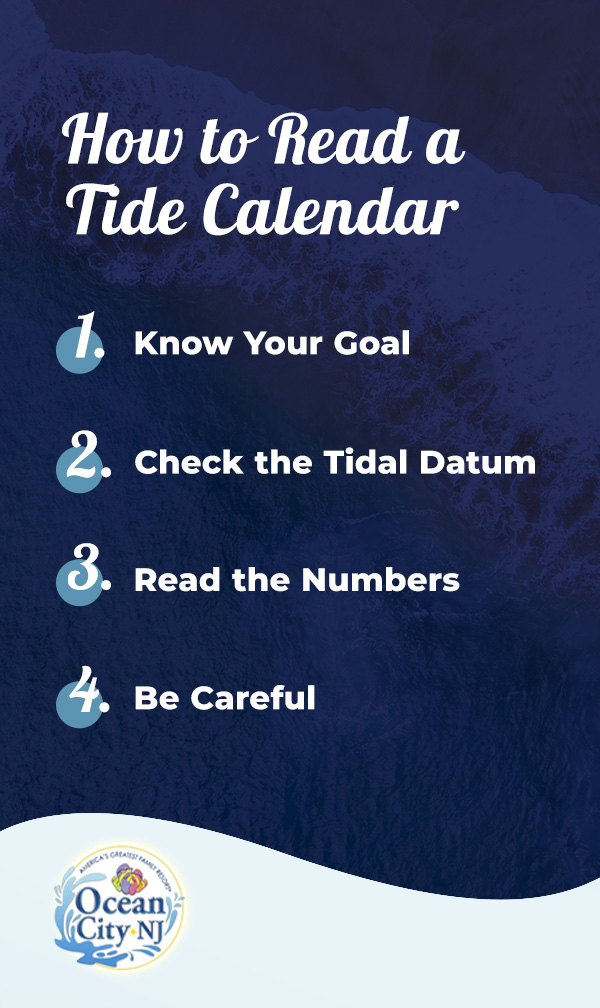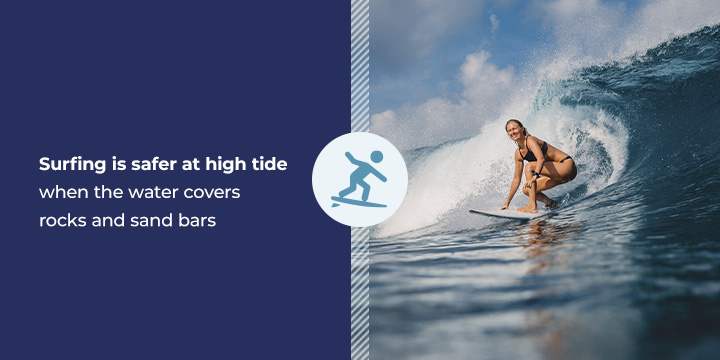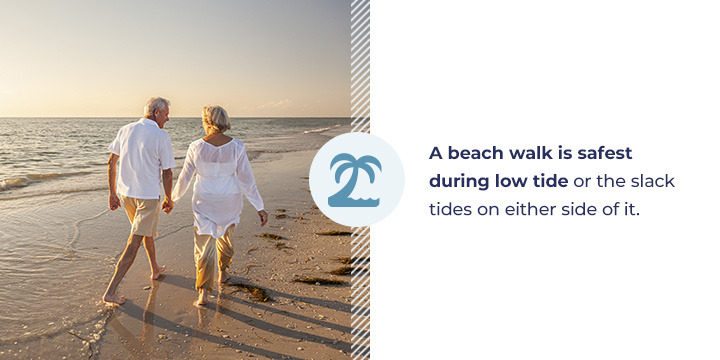How To Read a Tide Calendar: What Is High Tide and Low Tide
Picture your perfect beach day. Whether you plan on catching a wave, a fish or a break to sunbathe as the kids build sandcastles, the tide level will affect what’s possible. Before heading out, you’ll probably check the forecast — checking the tide is just as important for making your dream beach vacation a reality.
If you’re planning a beach outing for your family, you’ll want to check whether the tide will play along with the fun and games you have in mind. Knowing how to read a rides calendar will help you have the seaside day you envision.
What Is a Tide Calendar?
A tide calendar,also called a tide table, represents predicted high and low tides at a location over time. It displays the height of the water at high tide and low tide, as well as the corresponding date and time. When you read a tide calendar, you’ll know when high and low tides will occur and the expected height of the waves.
Tide charts are slightly different. While tide calendars display predictions for daily high and low tides, tide charts are mapsshowing hourly changes in tide levelsat a certain location.
One benefit of tide calendars is they show you information about high and low tides across the month so that you can plan your beach day in advance. They’re handy tools that help you enjoy your favorite beach activities with maximum fun and safety.
How to Read a Tide Calendar

You can read and understand a tide calendar in four easy steps.
1. Know Your Goal
You can read a tide calendar on the day of your beach excursion or when planning your outing:
- On the day of your beach trip:Check the tide calendar before heading out to the beach to determine what activities are possible.
- When you’re planning a trip:If you have a specific beach activity in mind, like surfing or walking, you can scan for the day and time with the right tide level for your activity.
2. Check the Tidal Datum
You’ll notice that the tide heights are marked with numbers that have a plus or minus next to them. These numbers indicate the tide is a certain height above or below alevel called the tidal datum. The tidal datum isthe baseline against which tides are measuredand marked with a plus sign (or no sign) if they’re higher and a minus sign if they’re lower.
The National Oceanic and Atmospheric Administration (NOAA) uses the Mean Lower Low Water (MLLW) to determine the tidal datum. The MLLW is observed over a 19-year period and describes the average height of the daily lowest tide.
3. Read the Numbers
Next, check the date, time and tide height numbers. Find the date you’re planning to head to the beach and what times are associated with high and low tide. Keep in mind that times might be in military format, and be sure to double-check whether tides occur in the a.m. or p.m.
In the United States, tables will note the wave heights in feet. If a plus sign accompanies a number — or the number is unmarked — it’s above the tidal datum. A number with a minus is below the datum. For example, -0.5 is a lower tide than -0.2.
4. Be Careful
A tide calendar can make accurate predictions based on astronomical cycles and past data. However, many variables affect the real height of the water. If you’re checking a tide calendar several days in advance, check again nearer to the date and time of your visit to be safe. And, of course, always pay close attention to your surroundings while at the beach.
What Is High Tide?
High tide describes the highest water levels that occur each day. Themoon’s and the sun’s gravitational pullscause tidal levels. Land features and weather can also influence tidal levels, but the moon has the strongest effect on our tides.
As the Earth rotates and the moon’s relative position changes,the moon’s gravity pullson the Earth’s water. When the moon is directly above a place like Ocean City, New Jersey, it pulls water toward it, and the water bulges up to a high level. Nearby coastal areas will experience rising water that covers more of the shore. This is what we call a high tide.
A place also experiences high tide when the moon is above the part of the Earth directlyon the opposite side of the planet. But why, when the moon isn’t directly over the water pulling on it? Essentially, the moon pulls the Earth toward it, causing the ocean on the opposite side of the world to bulge outward. It’s like a game of tug of war —on one side of the Earth, the moon is pulling water toward it. On the other, the Earth is pulling toward the moon. Both cause high tide!
This means that high tide occurs twice daily — roughly every 12.5 hours. The time they occur will shift about an hour later each day.
Weather, land features and celestial cycles also influence high tide. A tide calendar uses much of this information to provide specific and helpful tide-level predictions.
What Is Low Tide?
Low tide describes the lowest water levels that occur each day. The same factors as high tide cause low tide. The moon’s gravitational pull causes two bulges of high tide on opposite sides of the Earth. The places on the Earth that are farthest from these high tide bulge points will have their lowest tides. The water lays low, receding from the shoreline. This happens when the moon is perpendicular to that part of the Earth rather than directly above or opposite it.
Since low and high tides are parallel effects of the moon’s gravity, they follow the same relative pattern. There are two low tides each day, 12.5 hours apart. Their relative timing is constant unless other factors interfere, but they shift a little later each day.
The Best Tides for Beach Activities
Now that you know what a tide calendar is, how to read it and what high and low tides are, let’s look at some of your favorite beach activities. For each, we’ll share the best tides to help you make the most of that activity.
Best Tides for Swimming
You can have a great swim close to high tide or low tide. The tide’s movement is more important for your safety than its level.
The hours right before and after high and low tides are called slack tides, during which the water moves more slowly. Slack tides arethe ideal times to swim, as there is less danger of being dragged by the tide. So, any time within an hour before or after high or low tide is good for swimming. Less experienced swimmers may feel most comfortable swimming at a time close to low tide. If you prefer deeper water, you may want to swim closer to high tide time.
If you can access a table that mentions wave intervals — the time between waves — look for shorter intervals. These tend to indicate calmer waves.
Best Tides for Surfing

Surfing issafer at high tidewhen the water covers rocks and sand bars. However, surfers may prefer to go out between high and low tide, as high tide waves break close to the shore, limiting how long you can ride them. Plus, surfing spots are often more crowded during high tide, which can limit how many waves you get to ride. In many spots, it is dangerous to surf during low tide because obstacles are exposed, and the water can go out more quickly, forming a riptide.
Surfers often have the most fun when waves have larger swells and longer intervals between them.
Best Tides for Wading
If you prefer staying on your feet but want to get your legs wet, wading through the water can be relaxing and fun. Wading is safest in slack tides, especially in the gentle currents that form right after low tide when the water slowly comes back in.
Best Tides for Snorkeling
There are benefits to snorkeling during high and low tide. When you snorkel during high tide, you can enjoy clearer and deeper water, allowing you to see more marine life. However, during low tide, the water may be calmer. Plus, since the water has receded, you may be able to see areas that are otherwise submerged. During slack tide, water rests gently, and with little tidal current, you can enjoy safety and clear visibility to marvel at marine life in peace.
Best Tides for Fishing
Anglers and fishers often have thebest chance of catching fishduring a moving tide.
If you’re fishing when the tide is going out, you can catch fish hunting the critters that the falling tide sucks into the creeks, channels and pools of a bay or estuary. They may also gather at the mouth of the bay or estuary to catch outgoing prey.
The rising tide approaching high tide is good for fishing, too. Fish often follow the influx of ocean water. The water at this time is usually clearer and more oxygenated, which is an invitation for fish and an advantage for folks hoping to catch them. With the right strategy, incoming and outgoing tides are both great for fishing.
Best Tides for Paddleboarding
Paddleboarding is best enjoyed when currents are gentle. Aim for the slack tide around high tide for a safe and fun paddleboarding experience. This will get you over underwater obstacles and offer easier currents to paddle through.
Best Tides for Kayaking
You want to enjoy gentle currents and free passage over obstacles when kayaking. The best tide for that is the slack tide around high tide when rocks and sand bars are covered, and you can safely negotiate the current.
Best Tides for Beach Games
Low tide is ideal for playing games along the seashore with your family or friends. When the tide is low, you have more room for your sandy field or court. Have a blast playing beach volleyball, football, soccer or another favorite beach game. Just make sure children don’t run into the water to retrieve a ball when the tide starts moving out.
Best Tides for Beachcombing

A beach walk is safest during low tide or the slack tides on either side of it. These are excellent times to enjoy the sensation of soft sand beneath your feet as you comb the seashore.
Be sure to arrive at a safe destination before the tide starts coming in more quickly. Some low tide walkways can become vanishing islands as high tide draws nearer. During the lowest tides, when the numbers on the tide table fall below zero, you can peer into tidal pools where you may catch a glimpse of vibrant marine life.
Best Tides for Sunbathing
Perhaps your perfect beach day involves lying down on your favorite soft towel or the bare sand and soaking in the sun’s rays. After slathering yourself with sunscreen, grab your towel and settle down in a spot far enough from the surf to keep your beach bag dry but near enough to hear the soothing sounds of the breaking waves.
You could insert yourself into this tranquil scene during any tide, depending on the spot you scout on the sand. Low tide affords you more options. For safety, pick a spot further from the water during tides that are coming in or moving out more quickly. If you are likely to fall asleep, have an alert friend or family member nearby to keep an eye on you.
Whichever beach activity you enjoy, it’s important to consider what the tides will be throughout the duration of the activity. Tides are constantly changing, so plan ahead and remain vigilant. With that said, there is fabulous fun and refreshing relaxation to be had at the beach, whatever the tide!
Plan Your Beach Outing in OCNJ
If you’re searching for a destination that offers all these activities and more, schedule a trip to America’s Great Resort: Ocean City, New Jersey.
Families keep coming back to Ocean City because of its scenic seaside vistas and family-friendly fun. Enjoy the sun, sea and sand by day. Explore amusem*nt parks, miniature golf or mouthwatering local restaurants along the Boardwalk by night. From sunrise until sundown, Ocean City offersdelightful times and stunning sightsfor the whole family.
Ocean City’s iconic beaches are the ideal sandy canvas to paint your perfect seaside getaway. Whether you’re a thrill-seeking surfer, a sleepy sunbather or somewhere in between, our picturesque shorelines invite you to pack your swimsuit and leave your cares behind.
Previous ArticleOcean City Boardwalk Welcomes New Roadster Rally Next ArticleFather's Day in OCNJ